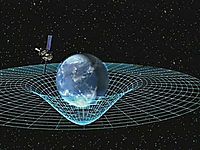
Photo from wikipedia
Band structures for electrons, phonons, and other quasiparticles are often an important aspect of describing the physical properties of periodic solids. Most commonly, energy bands are computed along a one-dimensional… Click to show full abstract
Band structures for electrons, phonons, and other quasiparticles are often an important aspect of describing the physical properties of periodic solids. Most commonly, energy bands are computed along a one-dimensional path of high-symmetry points and line segments in reciprocal space (the “ k -path”), which are assumed to pass through important features of the dispersion landscape. However, existing methods for choosing this path rely on tabulated lists of high-symmetry points and line segments in the first Brillouin zone, determined using different symmetry criteria and unit cell conventions. Here we present a new “on-the-fly” symmetry-based approach to obtaining paths in reciprocal space that attempts to address the previous limitations of these conventions. Given a unit cell of a magnetic or nonmagnetic periodic solid, the site symmetry groups of points and line segments in the irreducible Brillouin zone are obtained from the total space group. The elements in these groups are used alongside general and maximally inclusive high-symmetry criteria to choose segments for the final k -path. A smooth path connecting each segment is obtained using graph theory. This new framework not only allows for increased flexibility and user convenience but also identifies notable overlooked features in certain electronic band structures. In addition, a more intelligent and efficient method for analyzing magnetic materials is also enabled through proper accommodation of magnetic symmetry.
Journal Title: npj Computational Materials
Year Published: 2020
Link to full text (if available)
Share on Social Media: Sign Up to like & get
recommendations!